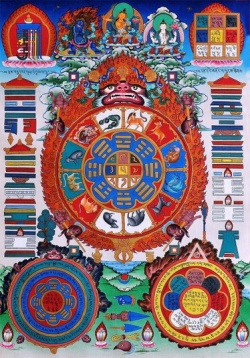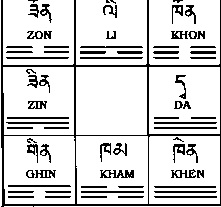Spar-Kha - The Tibetan Eight Trigrams
One of the most important divination system of Tibetan astrology is known as "Sino-Tibetan divination" or nag-rtsis (literally: "Chinese Calculations"). It should be noted that a confusion relating to the Tibetan term for "China" rGya-nag (literally: Black Lowlands) exists. In Tibetan language, nag can be at the same time an abbreviation of the geograpic and ethnic designation China/Chinese, as well as the adjective 'black'. Therefore it is no coincidence that Western scholars often translate nag-rtsis as "Black Calculations", yet this often raises the misconception of it being 'black' as in 'Black Magick', which is basically untrue. Another less ambiguous Tibetan term for this system is 'byung-rtsis, (literally: "Element Calculations"). The Elements are referring to the Chinese Five Elements (Wu Xing 五行)
A reason for identifying this system of astrology with 'blackness' could also be rooted in the fact that Tibetan historiography credits a mysterious 8th century AD Chinese scholar and translator, known only under his Tibetan name Duhar-nagpo (literally: Duhar The Black; his other aliases are slob-dpon or du-har-ba), with providing the first authoritative translations and explanations of Chinese divination techniques to Tibetan. Although Duhar-nagpo's bio-data and original Chinese name remain sketchy, all learned Tibetan astrologers know the title of his work: «Rin-chen gsal-sgron» ("The treasure-illuminating lamp"). Although the original work is believed to be lost, the 17th century Tibetan king-regent and scholar Desi sangs-rgyas rgya-mtsho (1653-1705) comments Durhar's work in his magnum opus on astrology and divination entitled: «Vaiḍūrya dkar-po» ("The White Beryll")
Tibetan Buddhists believe that originally the Bodhisattva Mañjusri (Tib: Jampel Yang) handed down this divination system via enlightened beings and scholars such as Duhar-nagpo to Tibetans so that they use it to subdue the Chinese.
In the contemporary political conetxt of the atheist People's Republc of China (PRC) brutally occupying Tibet, this can only be seen as prophetic. During Mao's (d. 1976) reign, Chinese were prohibited by law to practice divination - let alone read - the I-Ching. Only In the 1990ies it became fashionable for Chinese citizens of the PRC to study the I-Ching again. That decade interestingly marks the ditching of Mao's ideology by the Chinese communists and the beginning of them whole heardedly embracing predatory capitalism and naked consumerism. - the betrayal of everything Mao had strived for by his own successors.
Tibetan astrology is familiar with the Chinese Eight Trigrams (Ch. Ba Gua 八卦). In Tibetan they are known as the spar-kha, pronounced: 'Bar Kah'.
The eight spar-kha correspond to the Eight Elements and eight cardinal points or directions. The following chart lists the spar-kha their corresponding Chinese equivalent and their directions.
- 1. ☰ the Creative Force, Sky: Khen (Ch: Qian 乾); direction: North West
- 2. ☱ the Joyous, Lake: Dva (Ch: Dui 兌); direction: West
- 3. ☲ the Radiant Sun, Fire: Li (Ch: Li 離); direction: South
- 4. ☳ the Arousing, Thunder: Zin (Ch: Zhen 震); direction: East
- 5. ☴ the Gentle, Wind: Zon (Ch: Xun 巽); direction: South East
- 6. ☵ the Abysmal, Water: Kham (Ch: Kan 坎); direction: North
- 7. ☶ the Calm, Mountain: Gin (Ch: Gen 艮); direction: North East
- 8. ☷ the Receptive, Earth: Khon (Ch: Kun 坤); direction: South West
This arrangement of the spar-kha is analog to the Chinese Eight Trigrams in the order of later heaven (Ch. Houtian Ba Gua 後天八卦), that basically tracks changes after they become manifest in the physical universe.
In his article "The Tibetan Image of Confucius", Shen-yu Lin cites ancient Tibetan scholars and their texts, relating to the origins of the spar-kha:
"The famous Tibetan scholar 'Jam mgon Kong sprul Blo gros mtha'yas (1813-1899) followed the traditional view on the issue pertaining to Kong tse 'phrul gyi rgyal po (i.e. the Tibetan name of the Chinese sage Confucius). In a paragraph in his encyclopaedic work «Shes bya kun khyab mdzod ("Treasury of All pervading Knowledge") which discussed the origin and transmission of Sino-Tibetan divination (nag-rtsis) in Tibet, he wrote:
The origin of the science, which is known as element-divination or Sino-Tibetan divination, is China. At the time of the first [[[Wikipedia:Chinese|Chinese]]] emperor sPa hu hshi dhi, a commoner living on the seashore offered a gold-colored turtle [to the emperor]. After [the emperor] examined it by way of looking upon it [carefully], the signs of the eight spar-kha appeared at the first time in his mind. On the basis of this, works of calculations pertaining to spar-kha, sme-ba (the "Nine magic-square numbers") and the twelve year-cycles were composed. On the basis of these, [related] works were composed successively by the incarnated kings, ministers and scholars. There are a lot of texts which appeared later, particularly, ‘Khong spu tsi', the incarnation of Mañjughosa, who is known as Kong tse 'phrul rgyal in Tibet, also introduced infinite texts about calculation and gTo. The former and the latter [[[Wikipedia:Chinese|Chinese]]] princesses first brought the texts of Chinese divination here to Tibet and initiated the [corresponding] system."
Apart spar-kha, the nag rtsis also include the sme-ba system or Nine magic-square numbers. Sme-Ba (pronounced 'May-Wah'), literally means black mole or spot on the skin. The magic-square numbers derive from a square, divided into nine boxes, and in each box of which is a number from 1 to 9, arranged in such a way that adding the three numbers horizontally, vertically, or diagonally always equals 15.


